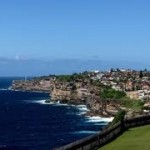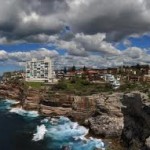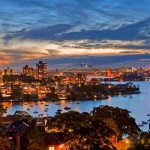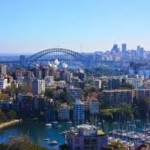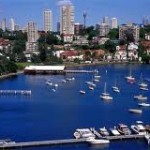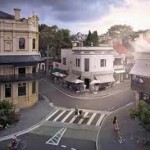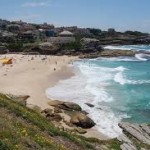With Sydney Harbour as its northern boundary, and the Pacific Ocean to the east, Vaucluse is sublimely sited for luxurious living. Its earliest residents were the pioneering Wentworth family who built the family home, Vaucluse House, which is still in the crook of a valley encircled by Olola Avenue.
Since the early part of the 20th century, Vaucluse has been home to Sydney’s affluent either in their waterfront mansions or on large hillside tracts with magnificent views.
The suburb of the Woollahra Municipality. The name is derived from the village in Provence, France, Fontaine de Vaucluse to which the Italian poet Petrarch retreated in 1337 – suffering from a distant amorous relationship with a ‘Laura’ and disenchantment with secular society, The name came from the Latin Vailis clausa, a closed valley and bestowed by Sir Henry Browne Hayes to the property, an amalgamation of the Laycock and Cardell grants which he ‘bought’ in 1803, building a cottage nearby and left in 1812.
Dover Heights is located on the eastern coast of Sydney in the municipality of Waverley.
Yeshiva College, located in Dover Heights, was used by the defence forces during the Second World War and was later acquired by the CSIRO and operated as the Dover Heights Field Station, housing a radio telescope. Between 1946 and 1954, the Field Station was responsible for many discoveries beyond our galaxy.
Renowned for its wide streets, fine homes, sunny elevated aspect and superlative ocean views, Dover Heights provides a relaxing, leisurely lifestyle conveniently located to the culinary and shopping delights of neighbouring beach suburbs North Bondi and Rose Bay.
Dover Heights is believed to have been named for its cliffs along the Pacific Ocean which resembled those found at Dover, in Kent, England. The first mention of Dover Heights appeared in municipal records in 1886. The area was first used for market gardens.
In 1830 land in the area was owned by Daniel Cooper (1785–1853), a partner in the firm Cooper and Levey, who owned the Waterloo Stores. The retailing emporium was located on the corner of George Street and Market Street in the city, on the site that was later occupied by Gowings Brothers retailers until 2006. The Dover Heights area was subdivided in 1913.
Watsons Bay takes its name from Robert Watson who served on HMS Sirius when it arrived in Sydney in 1788. By 1811, Watson had been appointed Sydney’s harbour pilot and harbour master, and by 1816, the first Superintendent of South Head’s Macquarie Lighthouse, designed by Francis Greenway
Until the 1950’s, Watsons Bay was very much a fishing village, but in recent decades its sublime views of the Harbour and ocean, combined with its proximity to the CBD has seen it change into a chic residential suburb.
The exclusive suburb of Rose Bay is a distinguished and upmarket harbourside address, just 6km east of the CBD. The famous Catalina restaurant sits on its picturesque shores, the destination for many power lunches for Sydney?s elite. From the prized balcony seats you can watch the seaplanes taking off, escorting flyers on sightseeing trips or jaunts up to famous restaurants such as Jonah’s at Whale Beach or the Cottage Point Inn.
Rose Bay features an abundance of recreational attractions, including the exclusive Royal Sydney Golf Club and the neighbouring Woollahra Golf Course. Take leisurely walks along the waterfront, take in a game of tennis by the harbour or indulge in any manner of water activities.
Its architecture is varied, from classic freestanding Federation homes and Californian bungalows on large parcels of land to Art Deco apartments and sleek contemporary boutique developments.
Rose Bay shopping village at the junction of New South Head Road and Dover Road offers a top selection of cafes, gourmet stores, supermarkets, specialty shops and a pub. Along Old South Head Road you?ll also find another charming hub replete with a host of eateries and amenities.
Many of Sydney?s top schools are located in and around Rose Bay, including the prestigious private girls? schools Kincoppal Rose Bay, Kambala and Ascham, the private boys? schools Scots College and Cranbrook, the co-ed private school Reddam House and the local government high school Rose Bay Secondary College.
The area is well serviced by buses which take you to the CBD or the main transport interchange of Edgecliff Station.
ROSE BAY – was named after The Right Honourable George Rose (he was not knighted) who was joint Secretary to the British Treasury with Thomas Steele, after whom Steel(e) Point at Nielsen Park was named. The name Rose
Bay was used as early as 1778 by Captain John Hunter (Peter Poland in The Right Honourable George Rose discusses the origin of the name).
In the early 19th century, Irish-Australian immigrants referred to the area as Vinegar Hill, after the Battle of Vinegar Hill, an engagement during the 1798 uprising of the United Irishmen in south-east Ireland. Governor Lachlan Macquarie took great exception to this and decided to name the suburb Bellevue Hill, the belle vue meaning beautiful view.[3]
Later in that century, Bellevue Hill became the home of the Fairfax family, who lived at Trahlee, in Ginahgulla Road, which was leased by James Fairfax from 1866 to 1878. They then moved to Fairfax House (also known as Ginahgulla), in the same road. The original lease for the land on which Trahlee stands was taken out by Lancelot Threlkeld in 1859.
What is now the Darling Point area was originally known as Eurambi, Yarranabbi, Yarrandabbi and Yaranabe by the local Aboriginal people. It was named Darling Point in recognition of Elizabeth Darling, the wife of New South Wales Governor Ralph Darling.[3] The traditional owners of Darling Point were generations of the Birrabirrgal people.
The history of European settlement in Darling Point begins in 1828 when a Arthur Kemmis applied for a land grant to establish a whaling business. However Governor Darling refused stating that the land would be held for public use. However, the land was eventually sold into private use.
Double Bay takes its name from the bay situated on Sydney Harbour. It refers to the two geographical formations between Point Piper and Darling Point, which are interrupted by a miniature point in between. The eastern part is also known as Blackburn Cove. Double Bay developed soon after initial European Settlement in 1788. In the early years of the colony, Double Bay was used as shelter for fishermen who would regularly fish around the harbour. Farming mostly cattle and lettuce a farm had developed and by 1814 it had increased to envelop the valleys leading into the area currently known as Woollahra, Bondi Junction, Bellevue Hill, and Point Piper
Edgecliff takes its name from its location because it literally sits on the edge of a cliff. The rocky cliff was extensively quarried in the early day of European settlement. The area was dominated for some time by the Glenrock property, on the north side of New South Head Road. Sir Edward Knox built Fiona in 1864 after having it designed by J.F.Hilly. It has been described as “a Classical Revival two-storey mansion” and was made of sandstone. Other elements of the estate included Glenrock, an Italianate residence designed by David MacBeath and built by John Marks circa 1870. There were also substantial gates of wrought iron and sandstone. The building was demolished when New South Head Road was widened, but the gates survived. Also on the estate was the Dower House, a Victorian Gothic Revival house of sandstone, built some time after 1842 by Whistler Smith. The estate is now the site of Ascham School, and the above items are on the National Estate
In the early 1820s, ex-convict entrepreneur and gin distiller Robert Cooper set out to build a grand Georgian estate at the top of Paddington’s ridgeline, affording excellent views. He named the area Paddington after a London borough. He called the estate Juniper Hall, which remains Paddington’s oldest home. The district’s first cottages were built around Victoria Barracks, formerly a major army base. In the latter part of the 19th century, many terrace houses were constructed to house the city’s burgeoning working population and an emerging middle class. Over time, these houses filled up almost every parcel of land, causing the suburb to become overpopulated. The unfashionable nature of the suburb continued until the mid-1960s, when gentrification took hold. At this time the area developed a bohemian aspect with a large arts community attracting creative and alternative residents. The suburb is now an example of uncoordinated urban renewal and restoration, where desirable location and heritage charm have contributed to flourishing real-estate values. Old boot-repair and linen shops have given way to designer fashion outlets and gourmet food. Since 1973, the suburb has also featured a [4] bohemian market, conducted each Saturday in the grounds of the Paddington Uniting Church and the playground of the adjacent Paddington Public School.
Point Piper was named after Captain John Piper (1773–1851). Piper was a Scottish-born military officer of Cornish parentage, who arrived in the colony in 1792 and built a neo-Palladian mansion on the point, on 190 acres (0.77 km2) of land granted by the governor in 1816. After a review of Piper’s performance as head of the Customs Department showed that he had mismanaged funds (although he was not actually accused of being corrupt), Piper attempted to drown himself in Sydney Harbour. He subsequently sold his holdings at Point Piper, Rose Bay, Neutral Bay, and Petersham, for £5,000 and moved to the country.
In 1834, Piper’s former residence was leased by Colonel John George Nathaniel Gibbes (1787-1873), the newly arrived Collector of Customs for New South Wales and a Crown appointee to the colony’s Legislative Council. Colonel Gibbes and his family resided at Point Piper House (also known as Henrietta, or Naval, Villa) until 1844, when they moved to “Wotonga” on Kirribilli Point. Wotonga now forms part of Admiralty House. Unfortunately, Point Piper House was torn down in the 1850s and the site redeveloped.[3]
The traditional Aboriginal owners of much of the Woollahra district were the Cadigal band, while the harbour area around Watsons Bay and South Head was inhabited by the Birrabirragal band. Both the Cadigal and Birrabirrigal clans belonged to the coastal Dharug language group.
The name Woollahra may have its origins in the Aboriginal word/s variously recorded in the 18th and 19th centuries as ‘Woo-la-ra’, ‘Willarra’ and ‘Wallara’. In 1788 the First Fleet officer Daniel Southwell translated the Aboriginal word ‘Woo-la-ra’ as meaning ‘The Look-out’. Surveyor James Larmer in 1832 reported the Aboriginal name for Point Piper as ‘Willarra’, also recorded as ‘Wallara’ by Surveyor General Sir Thomas Livingstone Mitchell (‘Aboriginal placenames: naming and renaming the Australian landscape’, ed. by Hercus & Koch, ANU Press, 2009).
Sydney’s most famous beach – Bondi Beach is the central landmark of Bondi. The alluring golden sweep of sand is one of the city’s great icons. The Bondi Pavilion, built in the 1920s, is Sydney’s grandest bathing pavilion. Nearby, there’s Bronte House, one of the oldest houses still standing in the eastern suburbs.
Stroll the length of Bondi Road and you’ll be able to eat your way around the world from Thai, Italian and Greek to Jewish and European. Or you could grab fish and chips from The One That Got Away or a Portuguese chicken from Oporto and head to Bondi Beach.
Often tagged ‘Glamarama’, this little beach tucked between Bondi and Bronte is frequented by the beautiful people. The surf here is often unpredictable, but that doesn’t stop the crowds flocking here in summer.
Tamarama is approximately 7km from the CBD by road. Its well served by public transport with buses to Bondi Junction and connections to the city by bus or rail. There are also buses to Bondi and North Bondi.
Bronte has been voted n the the past as Sydney best suburb by the Herald’s Good Suburbs Guide.
The guide’s editor, Stephen Nicholls, said only Bronte had the full package. “It’s got a great beach, great cafes, a great primary school and [it’s] so close to the city. Where else in the world can you have a suburb with so much going for it?”
Bronte can be found on the coast just east of central Sydney. Its original name was Nelson Bay, after the Admiral. By 1836 the first land grants had occurred and the foundations for the great Bronte House had been laid.
The coastline is a dedicated nature reserve, and the surf is one of the safest and finest on the southern side of Sydney harbour.

